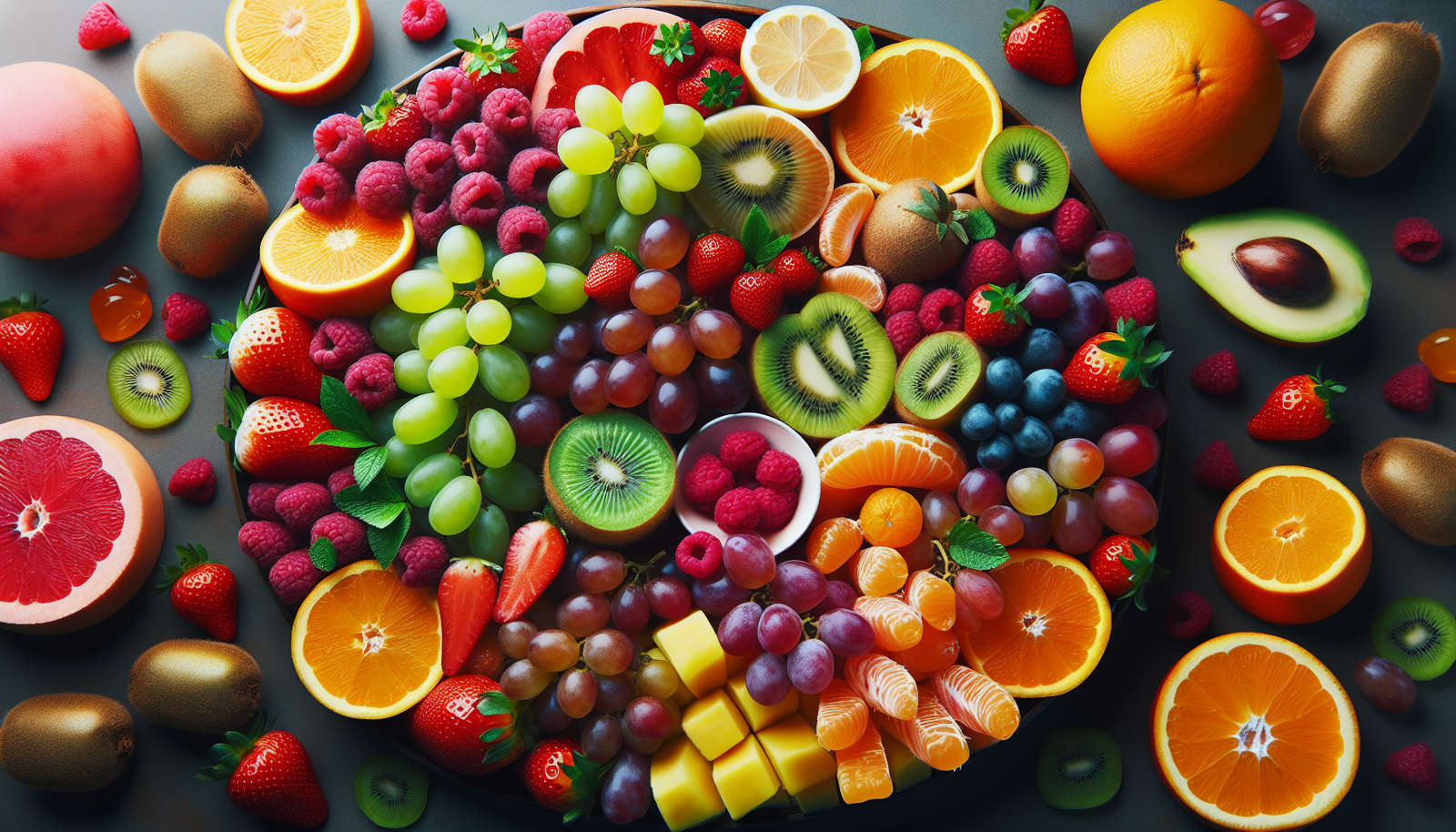If you’re conscious about maintaining a healthy diet, having a good understanding of the glycemic index of fruits is vital. This index is a valuable tool that helps determine how different fruits affect your blood sugar levels. By being aware of which fruits have a high or low glycemic index, you can make informed choices about what you include in your daily meals and snacks. In this article, we will explore the basics of the glycemic index and shed light on the glycemic index values of various fruits, providing you with the necessary knowledge to make healthier fruit choices.
What is the Glycemic Index?
Definition
The glycemic index (GI) is a scale that ranks carbohydrates based on their effect on blood sugar levels. It measures how quickly and to what extent a particular food raises blood glucose levels. The scale ranges from 0 to 100, with higher values indicating a faster and larger increase in blood sugar levels. Foods with a low GI are digested and absorbed more slowly, leading to a gradual rise in blood sugar levels, while foods with a high GI are rapidly digested and cause a sharp increase in blood sugar levels.
Importance
Understanding the glycemic index is important because it provides valuable information about how different foods can affect your blood sugar levels. For individuals with diabetes or those trying to manage their blood sugar levels, knowing the glycemic index of foods can help them make healthier choices. By opting for low GI foods, they can prevent blood sugar spikes and maintain more stable glucose levels throughout the day. Additionally, the glycemic index can also be useful for individuals looking to manage their weight, as foods with a lower GI may keep you fuller for longer and help control cravings.
Factors Affecting Glycemic Index
Several factors can influence the glycemic index of a food. The ripeness of fruits is a significant factor, as ripe fruits tend to have a higher GI compared to unripe ones. Processing and cooking methods can also impact the glycemic index. Generally, processing and cooking foods increase their GI as the starches are broken down, making them more quickly absorbed by the body. Additionally, the presence of fat and fiber, as well as the type of carbohydrates in a food, can affect its glycemic index. Foods with higher fiber content generally have a lower GI, as fiber slows down digestion and absorption.
Understanding Glycemic Index of Fruits
Definition of Glycemic Index of Fruits
The glycemic index of fruits refers to the ranking system that measures how specific fruits affect blood sugar levels compared to pure glucose, which is assigned a GI value of 100. Fruits are a natural source of carbohydrates, including sugars, and understanding the glycemic index of different fruits can be beneficial for managing blood sugar levels.
Why it is Important to Know the Glycemic Index of Fruits
Knowing the glycemic index of fruits is crucial for individuals with diabetes or those watching their blood sugar levels. Fruits are generally considered healthy, but their varying glycemic index values mean that some fruits may cause a more significant spike in blood sugar levels than others. By choosing fruits with a lower glycemic index, individuals can enjoy the health benefits of fruits without experiencing sudden blood sugar fluctuations.
How Glycemic Index is Measured in Fruits
To measure the glycemic index of a fruit, participants are given a controlled portion of the fruit and their blood sugar levels are monitored over a specific period of time, usually two hours. The results are then compared to the blood sugar response of the same participants after consuming a control food, typically pure glucose. The incremental area under the curve for blood glucose levels is calculated to determine the fruit’s GI value.

Low Glycemic Index Fruits
Benefits of Consuming Low Glycemic Index Fruits
Consuming low glycemic index fruits offers numerous benefits for individuals with diabetes or those aiming to manage their blood sugar levels. These fruits help maintain more stable blood glucose levels and prevent the sudden spikes and crashes associated with high GI foods. Low glycemic index fruits provide a slower and more sustained release of energy, making them suitable for promoting satiety and supporting weight management. Additionally, low GI fruits may also have long-term health benefits, such as reducing the risk of heart disease and improving insulin sensitivity.
Examples of Low Glycemic Index Fruits
Some examples of low glycemic index fruits include:
-
Cherries: Cherries have a GI of 22, making them a great choice for individuals looking to manage their blood sugar levels.
-
Apples: With a GI of 34, apples are a nutritious and low GI fruit that can be enjoyed as a snack or added to various dishes.
-
Plums: Plums have a GI of 39 and are packed with vitamins, minerals, and antioxidants.
-
Oranges: Oranges have a GI of 40 and are known for their high vitamin C content.
High Glycemic Index Fruits
Effects of Consuming High Glycemic Index Fruits
Consuming high glycemic index fruits can result in a rapid and substantial increase in blood sugar levels. This sudden spike is followed by a rapid decline, which can leave individuals feeling lethargic and hungry. For individuals with diabetes or those trying to manage their blood sugar levels, regularly consuming high GI fruits can make it challenging to maintain stable glucose levels and may require additional insulin or medications. High GI fruits are best consumed in moderation and balanced with other low GI foods to minimize their impact on blood sugar.
Examples of High Glycemic Index Fruits
Some examples of high glycemic index fruits include:
-
Watermelon: Watermelon has a GI of 76, primarily due to its high sugar content. While it is a refreshing fruit, individuals with diabetes should consume it in controlled portions.
-
Pineapple: Pineapple has a GI of 66 and is known for its sweet and tangy flavor. Moderation is key when including pineapple in a diabetic-friendly diet.
-
Dates: Dates have a GI of 103, making them one of the highest GI fruits. They are very sweet and should be restricted for individuals with diabetes or consumed sparingly.
-
Ripe bananas: Ripe bananas have a higher GI compared to unripe ones due to the increased sugar content. Individuals with diabetes may want to opt for unripe bananas or consume ripe bananas in moderation.

Glycemic Load vs. Glycemic Index
Difference between Glycemic Load and Glycemic Index
While the glycemic index ranks foods based on their effect on blood sugar levels, the glycemic load takes into account both the glycemic index and the portion size of the food consumed. The glycemic load provides a more accurate measure of how a specific food will impact blood sugar levels by considering the real-life serving sizes.
How to Calculate Glycemic Load
Glycemic load is calculated by multiplying the glycemic index of a food by the grams of carbohydrates in a serving, then dividing the result by 100. This calculation factors in the portion size, offering a more practical and realistic understanding of a food’s impact on blood sugar levels.
Why Both Glycemic Load and Glycemic Index Matter
While the glycemic index is a useful tool for quickly comparing the relative impact of different foods on blood sugar levels, it may not provide a complete picture on its own. By considering the glycemic load alongside the glycemic index, individuals can better understand how much a food will raise their blood sugar levels and make more informed choices. Foods with a low glycemic index but a high glycemic load may still cause a significant increase in blood sugar if consumed in large quantities, so portion control remains important.
Impact of Fruit Ripeness on Glycemic Index
How Fruit Ripeness Affects Glycemic Index
The ripeness of a fruit can have a significant impact on its glycemic index. As fruits ripen, their sugar content increases while their fiber content decreases. This change in composition contributes to higher glycemic index values. Ripe fruits tend to have more easily digestible sugars, leading to a faster and larger increase in blood sugar levels.
Changes in Glycemic Index as Fruit Ripens
Certain fruits, such as bananas and mangoes, experience a notable increase in glycemic index as they ripen. In the case of bananas, unripe green bananas have a lower glycemic index compared to ripe yellow bananas. This is because the starches in the fruit change into natural sugars as they ripen. It is important to consider fruit ripeness when aiming to manage blood sugar levels and choose fruits accordingly.

Health Benefits of Consuming Fruits
General Health Benefits
Consuming fruits as part of a balanced diet provides numerous health benefits. Fruits are rich in essential vitamins, minerals, antioxidants, and dietary fiber. They support overall health, boost the immune system, and reduce the risk of chronic diseases such as heart disease, stroke, and certain types of cancer. Additionally, fruits are low in calories and high in water content, making them a great choice for weight management.
Role of Fiber in Fruits for Blood Sugar Control
Fiber found in fruits plays a crucial role in blood sugar control. It slows down the digestion and absorption of carbohydrates, preventing blood sugar spikes. Fiber also promotes satiety, helping individuals feel fuller for longer and reducing the likelihood of overeating. Consuming fiber-rich fruits can contribute to overall glycemic control and support a healthy diet.
Other Nutrients and Antioxidants in Fruits
Fruits are packed with various nutrients and antioxidants that promote overall health. They are an excellent source of vitamin C, potassium, folate, and other essential vitamins and minerals. Antioxidants found in fruits help protect against oxidative stress and inflammation, reducing the risk of chronic diseases. Including a variety of fruits in your diet ensures a diverse range of nutrients and antioxidants.
Glycemic Index vs. Individual Blood Sugar Response
Variations in Personal Blood Sugar Response
Individual blood sugar responses to specific foods can vary significantly. Factors such as genetics, gut health, overall diet, physical activity levels, and medications can influence how your body responds to different foods. While the glycemic index provides a general indication of a food’s impact on blood sugar levels, it may not accurately predict how an individual’s body will respond.
Factors Affecting Individual Blood Sugar Response
Several factors can affect an individual’s blood sugar response to specific foods. These include the presence of other nutrients in the meal, the cooking and preparation methods, and the overall macronutrient composition of the meal. Additionally, individual insulin sensitivity and metabolic health can also influence how effectively the body regulates blood sugar levels.
Considerations for Glycemic Index in Personal Diet
While the glycemic index can serve as a useful guide, it is important to consider individual factors and preferences when incorporating it into your diet. It is generally recommended to focus on overall dietary patterns rather than solely relying on the glycemic index of individual foods. A well-balanced diet that includes a variety of fruits, vegetables, whole grains, lean proteins, and healthy fats is key for overall health and blood sugar management.

Using Glycemic Index for Meal Planning
Incorporating Low Glycemic Index Fruits into Meals
Incorporating low glycemic index fruits into your meals is a simple way to promote stable blood sugar levels and overall health. Add berries like strawberries, raspberries, and blueberries to your breakfast cereal or yogurt. Snack on sliced apples or pears with some nut butter for a satisfying and low GI option. Include fruits like cherries, plums, and oranges in salads or as toppings for desserts.
Balancing Glycemic Index of Fruits with Other Foods
While incorporating low glycemic index fruits, it is important to balance their glycemic index with other foods in your meals. Pairing fruits with a source of protein or healthy fat can help slow down the digestion and absorption of carbohydrates, further reducing the impact on blood sugar levels. Additionally, adding fiber-rich vegetables and whole grains to your meals can contribute to overall glycemic control.
Glycemic Index and Weight Management
The glycemic index can also be a valuable tool for individuals aiming to manage their weight. Foods with a lower glycemic index tend to promote satiety and keep you feeling fuller for longer, which can reduce the likelihood of overeating and support weight management efforts. Including low glycemic index fruits as part of a well-balanced diet can help individuals achieve and maintain a healthy weight.
Conclusion
Understanding the glycemic index of fruits is essential for individuals looking to manage their blood sugar levels, maintain a healthy weight, and promote overall well-being. By choosing low glycemic index fruits and incorporating them mindfully into meals, you can enjoy the nutritional benefits of fruits without experiencing sudden blood sugar spikes. Consider your personal dietary goals and preferences, and work with a healthcare professional to create a well-rounded and individualized diet plan that includes a variety of fruits, vegetables, whole grains, lean proteins, and healthy fats. With this knowledge, you can make informed choices and enjoy the many health benefits that fruits have to offer.


